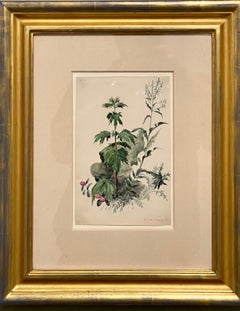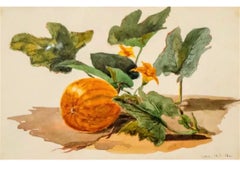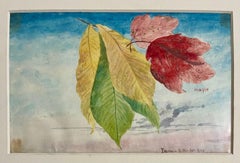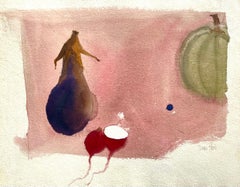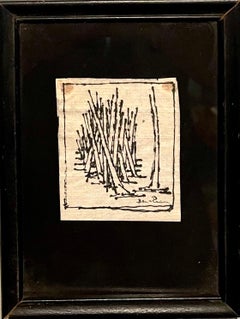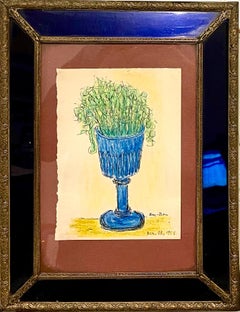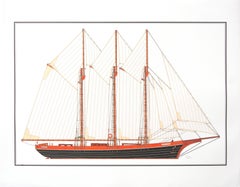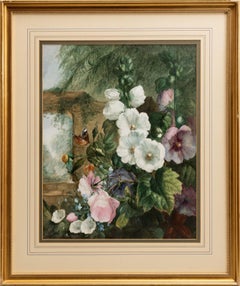Lions Gallery Still-life Drawings and Watercolors
to
9
2
3
Overall Width
to
Overall Height
to
2
12
1
1
2
2
1
7
3
1
8
6
1
1
1
8
8
6
5
3
3
2
1
1
1
4
14
Plants, Bristol 1863 Watercolor Painting American Artist Charles DeWolf Brownell
By Charles De Wolf Brownell
Located in Surfside, FL
Charles De Wolf Brownell (American, 1822 - 1909)
Watercolor on paper depicting several plants in close proximity
Hand dated and inscribed "Br...
Category
19th Century Naturalistic Landscape Drawings and Watercolors
Materials
Watercolor
Pumpkin Vine Watercolor Painting 19th C. American Artist Charles DeWolf Brownell
By Charles De Wolf Brownell
Located in Surfside, FL
Charles De Wolf Brownell (American, 1822 - 1909)
Watercolor on paper depicting a pumpkin on a flowering vine
Hand dated and inscribed "Lyme ...
Category
19th Century Naturalistic Landscape Drawings and Watercolors
Materials
Watercolor
Maple Leaves Watercolor Painting 19th C. American Artist Charles DeWolf Brownell
By Charles De Wolf Brownell
Located in Surfside, FL
Charles De Wolf Brownell (American, 1822 - 1909)
Watercolor on paper of maple leaves against the sky,
Hand dated and inscribed "Papaw - E.H....
Category
Early 1900s Naturalistic Landscape Drawings and Watercolors
Materials
Watercolor
Watercolor Still life Painting Vegetables Claus Hoien Greengrocer Kitchen Series
Located in Surfside, FL
Delicate watercolor of vegetables. Japanese eggplant and radishes and a squash gourd.
Framed 18 X 20 image is 11 X 13.5
Claus Hoie was a Norwegian-American...
Category
20th Century American Modern Still-life Drawings and Watercolors
Materials
Watercolor
Expressionist Miniature Drawing Wheat Stalks American Modernist Ben Zion WPA
By Ben-Zion Weinman
Located in Surfside, FL
Expressionist ink drawing of wheat stalks
There is an inscription "Happy New Year" on verso
Hand signed
Framed it measures 7.75 X 5.75
The actual paper is 3 X 3.5
Born in 1897, Ben-...
Category
1950s Expressionist Still-life Drawings and Watercolors
Materials
Ink
Expressionist Color Drawing Cobalt Glass Vintage Frame Modernist Ben Zion WPA
By Ben-Zion Weinman
Located in Surfside, FL
Expressionist ink and pastel crayon drawing of flowers in vase.
Framed in a vintage cobalt blue glass original frame
Hand signed and dated
Framed it measures 13.5 X 10.5
The actual ...
Category
1950s Expressionist Still-life Drawings and Watercolors
Materials
Paper, Oil Crayon, Pastel, Ink
Expressionist Ink, Pastel, Crayon Drawing Jewish American Modernist Ben Zion WPA
By Ben-Zion Weinman
Located in Surfside, FL
Expressionist ink and pastel crayon drawing of beans (carobs, flowers?) in pods
Hand signed.
Born in 1897, Ben-Zion Weinman celebrated his European Jewish heritage in his visual wo...
Category
Mid-20th Century Expressionist Still-life Drawings and Watercolors
Materials
Paper, Oil Crayon, Pastel, Ink
Boston Expressionist Conte Pencil Drawing "Still Life with Flies" Hyman Bloom
By Hyman Bloom
Located in Surfside, FL
Hyman Bloom
"Still Life with Flies"
Frame: 18" X 16"
Image: 9.25" X 8.25"
Hand signed with his monogram initials
Provenance: bears exhibition label from Fuller Museum of Art
Hyman B...
Category
1990s Abstract Still-life Drawings and Watercolors
Materials
Color Pencil
Israeli Yosl Bergner Modernist OIl Painting Kitchen Bottles Coffee, Vase
By Yosl Bergner
Located in Surfside, FL
Yosl Bergner
Abstract Composition, Kitchen Utensils.
Oil painting of kitchen implements. Hand signed in English bottom right
Titled and signed ve...
Category
Mid-20th Century Modern Still-life Drawings and Watercolors
Materials
Archival Ink, Watercolor
Israeli Yosl Bergner Modernist Watercolor Painting Drawing Pots, Pans
By Yosl Bergner
Located in Surfside, FL
Abstract Composition, Kitchen Utensils.
Ink and watercolor of kitchen implements. Hand signed in Hebrew upper left. Dimensions: (Frame) H 25" x 18" (Sight) H 18.5" x W 11.75"
Bergn...
Category
Mid-20th Century Modern Still-life Drawings and Watercolors
Materials
Archival Ink, Watercolor
Modern Polish Jewish Pencil Drawing Modernist Landscape
By Jehudith Sobel
Located in Surfside, FL
Jehudith Sobel (1924-2012 ) Polish/Jewish artist (also known as Judyta Sobel)
Judith Sobel was born in Lwow, Poland in 1924. After Word War II she attended the Academy of Fine Arts in Lodz, Poland from 1947-1950, where she studied with the famous Abstract Constructivist, Wladyslaw Strzeminski and Stefan Wegner from whom she learned the principles of Modern Art as per the European Cubists. She was also part of the First Exhibit of Modern Art in Krakow in 1948/1949. From Poland she emigrated to Israel, where she exhibited and was collected by the major art museums of Israel including the Museum of Modern Art at Haifa.
In 1956, Sobel came to New York on a scholarship and before that she lived in France for two years. Same year she received the First Prize at the Exhibition in the Saks Gallery...
Category
1960s Modern Landscape Drawings and Watercolors
Materials
Paper, Carbon Pencil
British Modernist Vibrant Watercolor Painting of Flowers
By Sir Jacob Epstein
Located in Surfside, FL
Sir Jacob Epstein KBE (10 November 1880 – 19 August 1959) was an American British sculptor who helped pioneer modern sculpture. He was born in the United States, and moved to Europe in 1902, becoming a British subject in 1911. He often produced controversial works which challenged ideas on what was appropriate subject matter for public artworks. He also made paintings and drawings, and often exhibited his work.
Epstein's parents were Polish Jewish refugees, living on New York's Lower East Side. He studied art in his native New York as a teenager, sketching the city, and joined the Art Students League of New York in 1900. For his livelihood, he worked in a bronze foundry by day, studying drawing and sculptural modelling at night. Epstein's first major commission was to illustrate Hutchins Hapgood's 1902 book Spirit of the Ghetto. Epstein used the money from the commission to move to Paris.
Moving to Europe in 1902, he studied in Paris at the Académie Julian and the École des Beaux-Arts. He settled in London in 1905 and married Margaret Dunlop in 1906. Epstein became a British subject on 4 January 1911. Many of Epstein's works were sculpted at his two cottages in Loughton, Essex, where he lived first at number 49 then 50, Baldwin's Hill (there is a blue plaque on number 50). He served briefly in the 38th Battalion of the Royal Fusiliers, known as the Jewish Legion during World War I; following a breakdown, he was discharged in 1918 without having left England.
In London, Epstein involved himself with a bohemian and artistic crowd. Revolting against ornate, pretty art, he made bold, often harsh and massive forms of bronze or stone. His sculpture is distinguished by its vigorous rough-hewn realism. Avant-garde in concept and style, his works often shocked his audience. This was not only a result of their (often explicit) sexual content, but also because they deliberately abandoned the conventions of classical Greek sculpture favoured by European Academic sculptors to experiment instead with the aesthetics of art traditions as diverse as those of India, West Africa, and the Pacific Islands.
Between 1913 and 1915, Epstein was associated with the short-lived Vorticism movement and produced one of his best known sculptures The Rock Drill.
Between the late 1930s and the mid-1950s, numerous works by Epstein were exhibited in Blackpool. Adam, Consummatum Est, Jacob and the Angel and Genesis, and other works, were initially displayed in an old drapery shop surrounded by red velvet curtains. The crowds were ushered in at the cost of a shilling by a barker on the street. After a small tour of American fun fairs, the works were returned to Blackpool and were exhibited in the anatomical curiosities section of Louis Tussaud's waxworks.
Bronze portrait sculpture formed one of Epstein's staple products, and perhaps the best known. These sculptures were often executed with roughly textured surfaces, expressively manipulating small surface planes and facial details. Some fine examples are in the National Portrait Gallery. He completed a bust of Winston Churchill...
Category
1930s Modern Still-life Drawings and Watercolors
Materials
Paper, Watercolor
Springtime Floral Bouquet
Located in Surfside, FL
Pastel, circa 20th century
Category
20th Century Modern Still-life Drawings and Watercolors
Materials
Paper, Oil Pastel
Small, Charming, Fauvist Painting Michel Henry French Modernist School of Paris
By Michel Henry
Located in Surfside, FL
Michel-Henry was born in Langres in 1928 and has shown strong passion for drawing since his childhood. Michel-Henry is acknowledged as an important painter in French contemporary art. From 1952 his work has periodically been singled out for France's highest prizes and awards. The French Government, the City of Paris , the Museum of Valence , Bogota and the Museum of Alencon are among the distinguished institutions who have acquired his work for their permanent collections.
Born in Langres in 1928 the aspiring artist attended the Ecole Nationale Superieure des Beaux-Arts in Paris. He later studied with Narbonne , Georg, Chapelain-Midy and Legueult. In 1957 he became a member of the House of Descartes in Amsterdam and the following year was named member of the Casa Velazquez in Madrid , honors which are exceptional for a young painter.
He is a member of the Salon d'Automne as well as a member of its jury, he also exhibits in the Salon de la Société Nationale des Beaux-Arts, the Salon Comparisons, and the Salon Terres Latines. In 1976 he shared in the honor of presenting the Salon d'Automne exhibition in Japan .
Michel-Henry blends delicate tones and strong and fascinating accents into his compositions of flower still life, landscapes and marines. An avid interest in nature is the predominant quality of his luminous works.
As a French artist whose works are known internationally, Michel-Henry over a period of twenty eight years has earned the status of a goodwill ambassador in a universal world of cultural exchanges. For his dedication and unselfish contributions to art and artists from all lands he was honored by his country by being awarded the prestigious - la Croix de Chevalier de la Légion d'Honneur - on January 1, 1981 by the French Minister of Culture Mr. Jean Philippe Lecat. Michel Henry exhibited at prestigious galleries in Paris (Avenue Matignon) and New York (Madison Avenue) alongside such artists as Pablo Picasso, Fernand Leger, Armand Guillaumin, Maurice Utrillo and Claude Venard. He is part of School of Paris artists that included Marcel Cosson, Jean Jansem, Leni-Dael, Raoul Dufy, Claude Salomon, Michel Kouliche...
Category
1960s Modern Still-life Paintings
Materials
Paper, Gouache
Related Items
"Freedom", Orange and Black Three-Masted Schooner Ink Drawing
By Philippe Mallet
Located in Clermont-Ferrand, Auvergne-Rhône-Alpes
This artwork depicts a three-masted schooner named Freedom, hailing from New-York. The boat has brown booms, masts, keel and bow, and black and orange hull...
Category
2010s Other Art Style Figurative Drawings and Watercolors
Materials
Paper, Ink
$589
H 21.66 in W 27.56 in
Hollyhocks and Roses in a Garden with Butterfly
Located in Stockholm, SE
This is a beautiful and highly decorative watercolor painting, featuring a charming garden scene filled with pink and white hollyhocks alongside blooming roses. Nestled among the del...
Category
Late 19th Century Naturalistic Still-life Drawings and Watercolors
Materials
Paper, Watercolor
$1,532
H 31.11 in W 26.38 in D 1.19 in
Untitled, Still Life of Shell
Located in Fairlawn, OH
Untitled, Still Life of Shell
Graphite on paper, 1945-1951
Signed lower right in pencil "Bisttram" (see photo)
Condition: Excellent
Sheet size: 9.63 x 7 .5 inches
EMIL BISTTRAM (189...
Category
1940s American Modern Still-life Drawings and Watercolors
Materials
Graphite
1920's Illustration of a Country Girl
Located in Soquel, CA
Finely detailed figurative illustration of a young woman leaning against a fence. The woman is wearing a plaid dress and bonnet with a black ribbon. Some of the landscape has been il...
Category
1920s Realist Figurative Drawings and Watercolors
Materials
Paper, Watercolor, Ink, Gouache
$556 Sale Price
20% Off
H 13.5 in W 10.25 in D 0.75 in
Landscape by Moonlight, Waterfall, Monthelier, French Romantic Art, Christmas
Located in Greven, DE
Fine Watercolour Drawing by Alexandre Jules Monthelier. He was a French Artist who worked in France and created many drawings of famous landscape and sceneries (e.g. the cathedral of...
Category
19th Century Romantic Landscape Drawings and Watercolors
Materials
Watercolor, Handmade Paper
White Poppies - Botanical Watercolor on Paper
Located in Soquel, CA
White Poppies - Botanical Watercolor on Paper
Detailed floral watercolor by Harry Federico (American, 1922-2022). Several white poppies ...
Category
21st Century and Contemporary American Modern Landscape Drawings and Wat...
Materials
Watercolor, Laid Paper
$747 Sale Price
35% Off
H 21.25 in W 27.25 in D 1 in
Prada Bag Ladies, Fashion New York City 2021. Watercolor fashion drawing on pape
By Manuel Santelices
Located in Miami Beach, FL
The artist has covered New York collections for over 16 years and has interviewed, as a journalist, several fashion designers and personalities for different publications. He loves t...
Category
21st Century and Contemporary Contemporary Figurative Drawings and Water...
Materials
Ink, Watercolor, Gouache, Pen
$700
H 12 in W 9 in D 0.1 in
A Stunning ca. 1950s Cubist Watercolor of Irises by Rita Duis (Astley-Bell)
Located in Chicago, IL
A stunning Cubist watercolor on paper of purple irises by Chicago and New York artist Rita Duis (Astley-Bell). Archivally matted to30" x 24".
Artist Rita Duis (Astley-Bell) led an ...
Category
1950s American Modern Still-life Drawings and Watercolors
Materials
Watercolor, Paper
$575 Sale Price
52% Off
H 30 in W 24 in
Bearded Irises - Floral Garden Watercolor Still-Life
By Jean Warren
Located in Soquel, CA
Lovely abstracted floral watercolor painting of bearded irises by artist Jean Warren (American, b. 1945). Signed "J. Warren" lower edge, bi...
Category
1980s American Impressionist Still-life Drawings and Watercolors
Materials
Watercolor, Laid Paper
Summer party at the Hoyt House. From the Art, culture & society series
By Manuel Santelices
Located in Miami Beach, FL
Movies, TV and magazines are constant source of inspiration. Fame, as fleckring and shallow it can be sometimes, is very intriguing to him.
The worlds of fashion, society and pop cu...
Category
21st Century and Contemporary Contemporary Figurative Drawings and Water...
Materials
Paper, Ink, Watercolor
$550
H 12 in W 9 in D 0.1 in
Flower Bouquet
Located in Los Angeles, CA
(Note: This work is part of our exhibition Connected by Creativity: WPA Era Works from the Collection of Leata and Edward Beatty Rowan)
Watercolor on paper, 12 x 9 ½ inches unframed sheet, 15 x 12 ½ inches framed, signed lower left
About the Artist:
Nan Watson...
Category
1930s American Modern Still-life Drawings and Watercolors
Materials
Watercolor
Garden Flowers
By Charles Demuth
Located in New York, NY
Charles Demuth was one of the most complex, talented, and deeply sensitive artists of the American modern period. Whether he was painting floral still lifes, industrial landscapes, or Turkish bathhouses, art was, for Demuth, fraught with personal meaning. A fixture of the vanguard art scene in New York, Demuth navigated the currents of Modernism, producing some of the most exquisite watercolors and original oil paintings in twentieth-century American art.
Demuth was born in Lancaster, Pennsylvania, the only child of a well-to-do family. He had an awkward and introverted childhood shaped by a childhood illness, Perthes, a disease of the hip that not only left him permanently lame, but, as part of the “cure,” bedridden for two years in the care of his mother. This long period of incapacitation had a deep impact on Demuth, who came to see himself as an invalid, an outsider who was different from everyone else. It was perhaps during this period of indoor confinement that his keen interest in art developed. Several relatives on his father’s side had been amateur artists, and, following his convalescence, his mother encouraged his artistic pursuits by sending him to a local painter for instruction. The majority of his early pictures are of flowers, a subject for which Demuth maintained a lifelong passion.
Following high school, Demuth enrolled at the Drexel Institute of Art in Philadelphia, a school renowned for its commercial arts program. He advanced through the program rapidly, and, in 1905, at the encouragement of his instructors, he began taking courses at the Pennsylvania Academy of the Fine Arts. The two leading teachers then at the Academy were William Merritt Chase and Thomas Anshutz. Anshutz, himself a former student of Thomas Eakins, was well liked by his students, and is best known as the teacher of Robert Henri, John Sloan, and several of the other artists of the Ashcan School. Demuth, too, adopted a similar idiom, working in a controlled, realistic manner while at the Academy, where he remained until 1910.
In 1907, Demuth made his first trip to Europe, staying in Paris. He spent time on the periphery of the art scene composed of the numerous American artists there, including John Marin and Edward Steichen. He returned to Philadelphia five months later, and immediately resumed courses at the Academy. Despite his introduction to advanced modern styles in Europe, Demuth’s work of this period retains the academic style he practiced before the trip. It wasn’t until he had summered at New Hope, Pennsylvania, in 1908 and 1911, that his style began to evolve. New Hope was a prominent American Impressionist art colony whose members were largely affiliated with the Pennsylvania Academy. Demuth dropped the conservative tone of his style and adopted a freer and more colorful palette.
Although he remained based in Philadelphia, Demuth frequently went to New York during this period. Many of the same American artists of the Parisian art scene Demuth had encountered on his earlier European trip now formed the nucleus of New York’s avant-garde, which centered around Alfred Stieglitz’s 291 gallery. It wasn’t long before Demuth began to apply modernist-inspired strategies to his work. He was particularly influenced by the watercolor work of John Marin, also a former student of Anshutz, whose bold use of color in the medium Demuth freely adapted into looser washes of color.
In 1912, Demuth again left for Paris, this time studying in the Académie Moderne, Académie Colorossi, and Académie Julian. In Paris Demuth met the American modernist Marsden Hartley. Hartley, a principal figure in the expatriate art circle, acted as a mentor to Demuth, and introduced him to the wide array of modern styles currently practiced in Europe. Hartley also introduced Demuth to many of the members of the Parisian avant-garde, including Gertrude Stein. Demuth was an aspiring writer, and he spent many hours in conversation with Stein. He wrote extensively during this period, and published two works shortly after his return to America. He also developed an interest in illustrating scenes from literary texts. From 1914 to 1919, Demuth produced a series of watercolors of scenes from books such as Emile Zola’s Nana and Henry James’s The Turn of the Screw.
Upon his return to America, Demuth settled in New York. In 1914, Demuth had his first one-man show at Charles Daniel’s gallery, which promoted emerging modern American artists, including Man Ray, Rockwell Kent, Yasuo Kuniyoshi, Stuart Davis, and Max Weber. Demuth drew closer to the artistic vanguard in New York, becoming friends with many in the Stieglitz and Daniel circles, including Georgia O’Keeffe, Marcel Duchamp, Carl Van Vechten, and Edward Fiske.
New York’s cosmopolitan atmosphere and active nightlife appealed greatly to Demuth. In a sketchy style well suited to watercolor, he painted many vaudeville and circus themes, as well as nightclub, café, and bathhouse scenes. Often with Duchamp, Demuth took part in an urban subculture replete with nightclubs, bars, drugs, and sexual permissiveness, which, for a homosexual artist like himself, allowed room for previously unattainable personal expression. Demuth’s pictures of sailors, bathhouses, and circus performers embody a sensual and sexual undercurrent, expressing the artist’s sense of comfort and belonging in the bohemian subculture of New York.
Simultaneously, Demuth deepened his interest in floral pictures, painting these almost exclusively in watercolor. His style evolved from the broad color washes of his earlier pictures to more spare, flattened, and sinuous compositions, inspired by the drawings of Aubrey Beardsley and other artists of the Aesthetic Movement. Demuth’s flower watercolors are moody and atmospheric, sensuous and elegant, introspective and yet full of expressive power. Moreover they are beautiful, and are unequivocally among the finest still lifes in American art. Despite numerous subsequent artistic undertakings that led him in a variety of directions, Demuth never stopped painting flower pictures, ultimately adding fruits and other still-life objects to his repertoire.
In 1916, Demuth began to develop a style later known as Precisionism, a form of landscape painting infused with Cubism, in which space is divided into precisely drawn geometric regions of color. Demuth first began to paint the landscape in an appropriated Cubist mode while on a trip with Hartley to Bermuda. In these early landscapes, in which the curvilinear forms of trees intersect the geometrically articulated architectural forms, Demuth explored ideas that shaped the future development of modernism in America.
The full realization of Demuth’s explorations came after his return to America in 1917, when he turned his attention to industrial subjects. These works derive from a “machine aesthetic,” espoused by New York artists such as Francis Picabia, Joseph Stella, Albert Gleizes, and Duchamp, by which artists viewed machines as embodying mystical, almost religious significance as symbols of the modern world. Rather than painting the skyscrapers and bridges of New York as did most of his like-minded contemporaries, Demuth returned to his home town of Lancaster, where he painted factories and warehouses in a Precisionist idiom. The titles for these pictures are often contain literary references, which serve as clues for the viewer to aid in the decoding of the artist’s meaning.
In 1923, Demuth planned a series of abstract “poster portraits” of his friends and contemporaries in the New York art and literary scene. In these “portraits,” Demuth combined text and symbolic elements to evoke the essential nature of his sitters’ distinguishing characteristics. In this fashion, he painted portraits of such artists as Georgia O’Keeffe, John Marin, and Arthur Dove. His most famous poster portrait, I Saw the Figure 5 in Gold...
Category
20th Century American Modern Still-life Drawings and Watercolors
Materials
Paper, Watercolor
